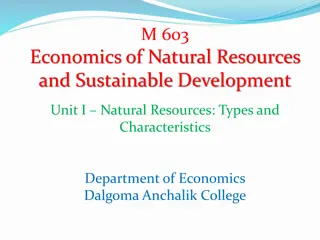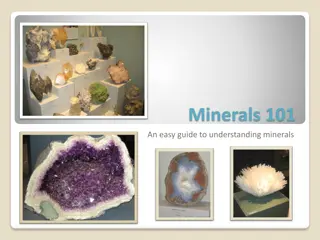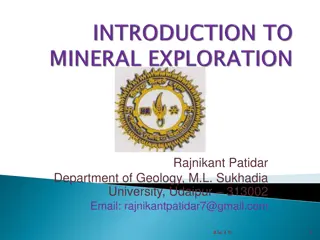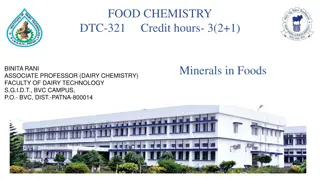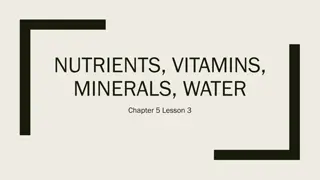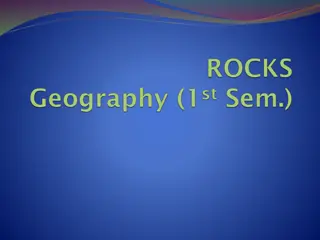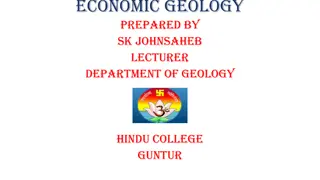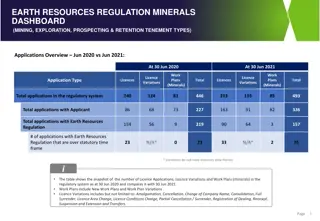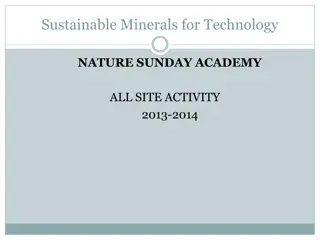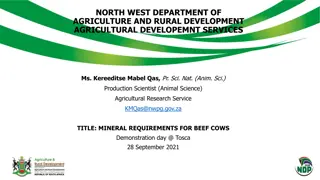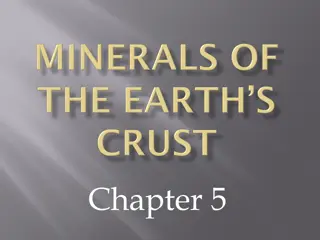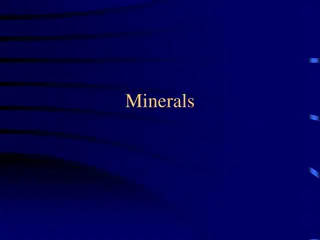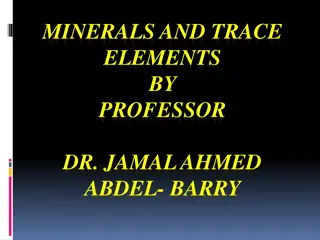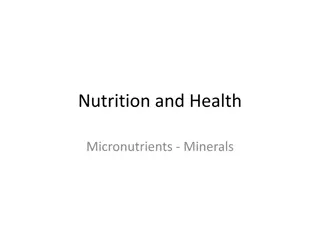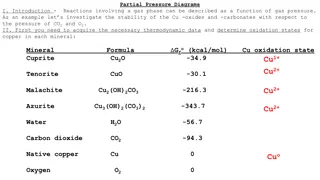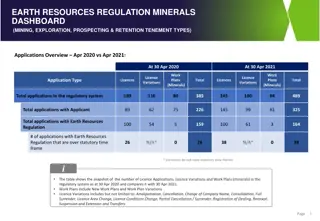Unveiling Earth's Riches: Resources, Minerals, and Sustainability
Australia is known for its abundant natural resources, including coal, gas, minerals, and metals. However, the country faces challenges with water scarcity. The Earth's crust holds valuable resources essential for everyday items and fuels. Understanding the importance of using resources wisely for a sustainable future is crucial. Mining for mineral ores like bauxite, galena, and haematite requires careful exploration due to the varying distribution in the Earth's crust. The thinness of the crust is compared to an apple skin, highlighting the Earth's delicate balance of resources. Conservation and responsible mining practices are vital for ensuring future generations can thrive in a healthy environment.
Download Presentation

Please find below an Image/Link to download the presentation.
The content on the website is provided AS IS for your information and personal use only. It may not be sold, licensed, or shared on other websites without obtaining consent from the author. Download presentation by click this link. If you encounter any issues during the download, it is possible that the publisher has removed the file from their server.
E N D
Presentation Transcript
PRECIOUS RESOURCES The riches below
When people describe Australia as being rich in resources, they are talking about coal, natural gas, oil, iron, copper, uranium and a host of precious minerals. But when it comes to the most precious resource of all water Australia is sadly lacking. Apart from Antarctica, Australia is the driest continent on Earth. All of our resources, whether they are fuels, precious minerals or water, must be used wisely to ensure that our future is sustainable that is, a future in which we and generations to come can live in a healthy environment.
The Earth's crust contains a vast range of resources used to make things that we take for granted every day; buildings, furniture, cars and plastics (including nylon and polyester) are just a few examples. It also provides the resources used to make fuels such as petrol, natural gas and coal.
THE EARTH'S CRUST The outer layer or crust of the Earth, which includes all landforms, rocks and soil, is made mostly of solid rock. A bit like a shell, it covers the whole planet. It varies in thickness from about 8 kilometres below the oceans to about 40 kilometres below the continents. The metals used in buildings, road vehicles, trams and trains, all electronic devices and many other are obtained from minerals found in the Earth's crust. Minerals are the natural substances that make up rocks, which are mixtures of two or more minerals. A substance that contains minerals of value is called a mineral ore. Minerals are non-renewable resources, because when they are mined and used they don't replace themselves quickly in fact, it can take millions of years.
Mineral ore Bauxite Galena Sphalerite Haematite Pentlandite Chalcopyrite Metal Aluminium Lead Zinc Iron Nickel Copper
HOW ABOUT THAT! To get an idea of how thin the Earth's crust is, take a medium-sized apple and cut it half. Now imagine that the apple is the Earth the crust by comparison is as thin as the apple skin!
NEEDLE IN A HAYSTACK The amount of any mineral in the Earth's crust varies greatly from place to place. Before any mining can be done, enough of a useful mineral resource must be found in a single location to make mining it financially worthwhile. The task of mineral exploration that is, finding useful resources worth mining is a bit like finding a needle in a haystack. Satellites equipped with cameras, radar and other sensors are used to look for features on the surface that provide clues about what could be below. Some minerals in the crust dissolve in rain and running water. They get washed into creeks and rivers, sometimes adding colour or chemical properties that can be detected by satellites, planes or geologists on the ground. Some minerals, such as those that contain iron, nickel and cobalt, can be detected because of their magnetic properties.
MINING THE MINERAL ORE The process of removing the mineral ore from the ground is called mining. The method used for mining depends on several factors, including: how close the mineral ore is to the surface how much rock lies above the mineral ore what type of rock lies above the mineral ore.
Open-cut mining is a method of mining mineral ores that are close to the surface. A large hole is made to expose the rocks containing the mineral ores. Explosives are used to break up the rock and huge trucks are used to transport the soil and rocks out of the mine. If the mineral ores are deep below the surface, underground mining is undertaken. Shafts and tunnels are dug deep into the ground to reach the mineral ore. Underground mining is more dangerous and expensive than open-cut mining. Shafts can be as deep as 4 kilometres. Temperatures in underground mines are high and there may be some danger from flooding, gas leaks or tunnels caving in.
EXTRACTING THE METAL After the rock containing a mineral ore is removed from the ground, the valuable part of it, the metal, is extracted. The method of extraction (or separation) varies from metal to metal. Most methods involve three separate stages.
Concentration of the mineral ore. The useful rock taken from the ground is a mixture of the useful mineral ore and unwanted sand, soil and other minerals. The unwanted substances are called gangue.
Reduction of the mineral ore to the metal. This involves a number of chemical reactions because the mineral ore is a pure substance, not a mixture. The reduction process often involves smelting, in which the mineral ore is melted. The reduction of aluminium ore requires additional and expensive processes, which is one of the reasons why recycling aluminium cans is so important.
Purification of the metal. Most metals obtained from the reduction process still contain impurities. These are removed using various chemical processes to produce the pure metal.
VIDEO Mining and Australia's Environment





